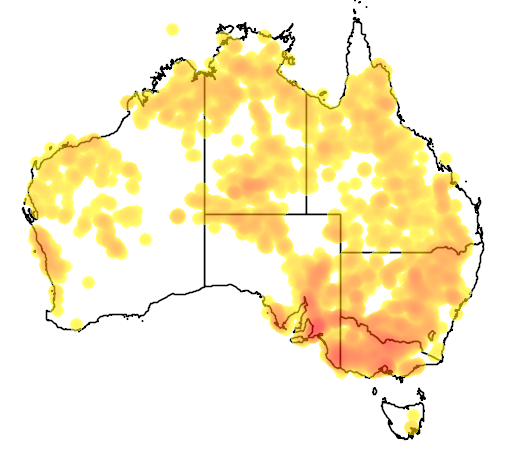Description
Common names
River Red Gum, Biall, Blue Gum, Creek Gum, Flooded Gum, Forest Gum, Murray Red Gum, Red Gum, River Gum, River Red-gum, River Redgum, Yarrah, Yarrow.
Scientific names
Eucalyptus camaldulensis.
Family
Myrtaceae.
Genus
Eucalyptus.
Name origin
Camaldulensis, River Red Gum first described from cultivated tree in garden of Camalduli religious order in Naples, Italy.
Rainfall
500mm.
Growth rate
Fast.
Growth height
Up to 30m.
Presence in Australia
Locally common along flats and watercourses in most districts. East of Hume Highway, mainly restricted to major watercourses such as the rivers Murray, Tumut and Murrumbidgee.
This specie has been identified in the following Australian states: Qld, NSW, ACT, Vic, Tas, SA, NT, WA.
Habitat
Dominant species in grassy woodlands or forests on deep rich alluvial soils adjacent to large permanent water bodies.
Habit
Tree to 30m high (occasionally taller) with smooth bark shedding in short ribbons or flakes. Large spreading crown with often heavy twisting branches and dull green or grey-green leaves.
Similar species
Distinguished from Blakely"s Red Gum (E. blakelyi) by its buds which are beak-shaped rather than cone-shaped. Refer to Practical Information Note - The Red Gum Story.
Site preference
Low country, inundated occasionally, or where underground water is generally available. Tolerates wind. Tolerance characteristics strongly related to provenance (locality). Some provenances tolerate salinity, drought, flood and fire (regenerating from a lignotuber).
Characteristics
Fast growing when young, and very long-lived.
Flowering
White, generally Dec-Feb. Flowers heavily every two or three years depending on season.
Seed collection
Mar-Sep, although collection times may vary. Monitor closely, as seeds dropped soon after maturity.
Propagation
From seed (±700 seeds per gram). 350C is optimum germination temperature.
Regeneration
From seed. Seedlings establish well as they take advantage of summer rains after weed growth has declined. Establishes particularly well along roadsides in sites which receive extra moisture.
Shade and shelter
Useful high-level cover in windbreaks. Grass grows up to trunk.
Land protection
Useful in controlling gully erosion. Can be planted in the bed of the gully, or further back behind fibrous-rooted understorey plants. Useful in controlling underground seepage, due to deep rooting. Water use in winter reduces waterlogging. Salt-tolerant provenances planted in salt discharge sites assist rehabilitation.
Fuel
Very good. Commercially used in producing charcoal.
Timber
Red, moderately hard, heavy and very durable. Density about 900 kg/m3. Resists decay and termites. Was used as railway sleepers, in flooring (especially parquetry), heavy construction, framing, decking, bridges, roadside markers, fencing, plywood, veneer, furniture and in turning.
Wildlife
Excellent habitat. The basis of many creek and river habitats. Excellent hollows, important nesting sites for many mammals and birds. Prolific pollen and nectar for wide range of insects and birds. Insect-eating birds attracted. Foliage important food for koalas, and nesting sites for many birds. Important for fish habitat, providing shade, an insect source, and fallen branches for snags that are egg-laying sites for fish such as the Murray Cod.
Koori
Canoes made from large sheets of bark, and scars remain on old trees. Smaller scars show where bark dishes were cut. Water containers made from large gnarled burls which were cut and hollowed out. Sweet drink was made from gum blossom which was soaked. Burns and diarrhoea treated with sap or gum, high in tannin. Seeds reputedly eaten.
Ornamental
Specimen and shade for large gardens and parks, useful in bog gardens and pond edges. Do not plant within 20m of plumbing to avoid clogging.
Other
Excellent honey tree. Dyes of varying colours produced from leaves, depending on mordants used. Gum was used in pharmaceutical preparations to treat diarrhoea and dysentery. Infusion of leaves and twigs was used to bathe the head for colds and fevers.


